Fleecing the Farm: How a Fake Crop Fueled a Bizarre $25 Million Ag Scam
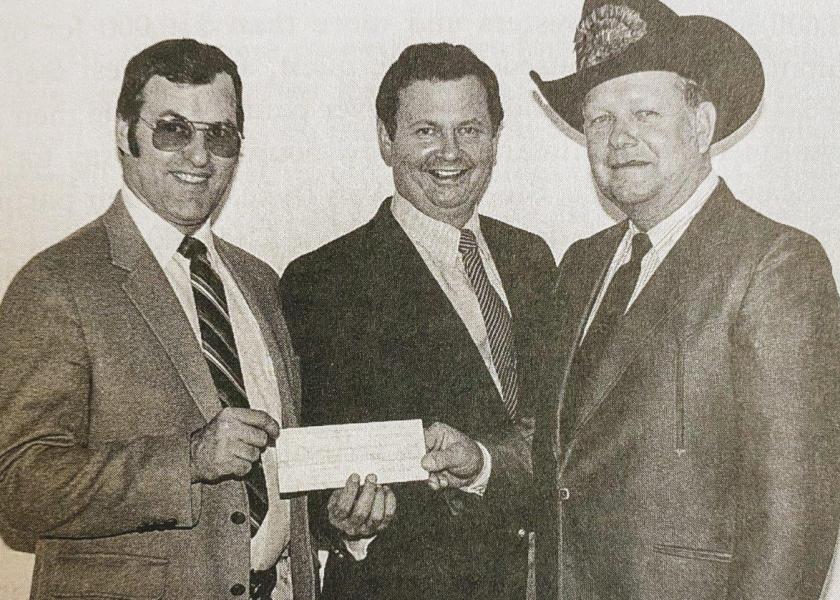
Why does a man need a Bible in hand to convince a farmer about the veracity of an obscure crop? Faith or duplicity? In the early 1980s, during the depths of a $25-million agricultural fiasco like no other, the question answered itself.
Welcome to the Jerusalem artichoke scandal, possibly the most outlandish major scam to curse agriculture in the past century. Built upon pure fantasy, the façade of an entirely new ag industry was erected, promising eternal energy sourced from the blessings of a heavenly tuber. Salvation, in the form of a potato-like plant of which most farmers had never heard, came with dizzying promise, potential, and purpose—but no market.
Strap on a seatbelt, grab the Dramamine, and rocket back to the beginning of a Jerusalem artichoke tent revival damned from the get-go and packed with a surreal cast of made-in-America characters pulled straight from the pages of a Twain novel. Truly, time and again, half-lies are a huckster’s currency.
Prophet Fred
Fred Hendrickson was forever on a wire between million-dollar prosperity and the poorhouse. Raised in the drylands of west-central South Dakota’s Haakon County, Hendrickson, born in 1935, envisioned riches around every corner, and jumped from one financial hope to the next, particularly drawn to the lure of alternative energy.

Emblematic of Hendrickson’s grandiose approach was the Igloo Project of 1980, a proposal to tap 27 million acres of South Dakota farmland and divide the ground into 490-square mile circles of biomass crops: grain sorghum, sweet sorghum, sugar beets, amaranth, Jerusalem artichokes, sunflowers, and safflowers. Farmers could buy in to the project for less than $5,000, and receive access to cooperative processing plants and marketing. Unable to secure a massive loan, Hendrickson watched the pieces of the proposal fall away—except for his keen interest in Jerusalem artichokes.
Hendrickson was convinced Jerusalem artichokes would fundamentally transform American agriculture, end all U.S. energy concerns, and permanently alter the global geopolitical scales. As prophesied by Hendrickson on Aug. 9, 1981: “From the soil shall spring the riches of all generations. Farm the ground, for out of it shall spring living waters and behold My Glory shall be yours.”
Hendrickson, the consummate shaker and mover, intended to turn an obscure tuber into a crop that controlled the destiny of nations. No market? No problem. No decades of research or agronomic history? No issue. No basis in reality? No matter.
Million-Dollar Weed
Cultivated by Native Americans and consumed by early colonists, Jerusalem artichokes are classically misnamed, with no connection to Israel, and no relation to traditional artichokes. Reaching well over 10’ in height, Jerusalem artichokes are part of the sunflower family, and produce ample tubers at the end of the root system.
Nebraska congressman Fred Johnson initially placed Jerusalem artichokes into public prominence with an eye-catching label in the 1940s: “the weed worth a million dollars.” Johnson was a proponent of the alcohol fuel movement of the 1920s and 1930s, insistent that the U.S. could end reliance on foreign oil by turning crops and cellulosic material into fuel. Further, a multitude of companies pumped out various forms of alternative fuels over the next several decades, but failed to gain long-term footholds. Alcogas; Vegaline; Agricultural Blended Motor Fuel; HiBall; Alcolene; Agrol; Koolmotor; Benzalcool; Moltaco; Lattybentyl; Natelite; Alcool—to name only a few.

Henry Ford was a leading alternative energy voice of the age, capsulized in his “chemurgy” beliefs. As Ford told a New York Times reporter in 1925: “The fuel of the future is going to come from fruit like that sumach out by the road, or from apples, weeds, sawdust — almost anything. There is fuel in every bit of vegetable matter that can be fermented. There’s enough alcohol in one year’s yield of an acre of potatoes to drive the machinery necessary to cultivate the fields for a hundred years.”
Hendrickson caught the bug of Johnson’s exuberance over Jerusalem artichokes, likewise convinced the tubers could save nation and farmer. His calculus was simple: Jerusalem artichokes provided dollars and U.S. farmers provided desperation. Indeed, Hendrickson’s assessment was spot-on, because by 1981, America’s farm economy had gone to hell.
The Great Circus
American farmers ran the gauntlet in the late 1970s and early 1980s, enduring a series of body blows brought on by inflation, anemic commodities, OPEC dominance, grain embargoes, and wild interest rates. (Interest rates rocketed from a 6.8% average in 1976 to 21.5% by 1981.)
For many Midwest growers, the specter of complete collapse knocked at the farm gate. Dire agricultural straits, according to Joseph Amato, produced a significant segment of farmers willing to try anything to avert a fall. “Look at any genuine crisis period and you see people searching for savior crops,” he says. “You see farmers engaging in more and more speculative venturing in order to survive.”
In 1993, Amato wrote the definitive account of the artichoke scam, The Great Jerusalem Artichoke Circus: The Buying and Selling of the Rural American Dream, and laid bare the contents of a deep artichoke layer cake. (Amato also penned When Father and Son Conspire, as well as multiple other agriculture-related accounts, and was among the founders of The Center for Rural and Regional Studies and The Society for the Study of Local and Regional History.)
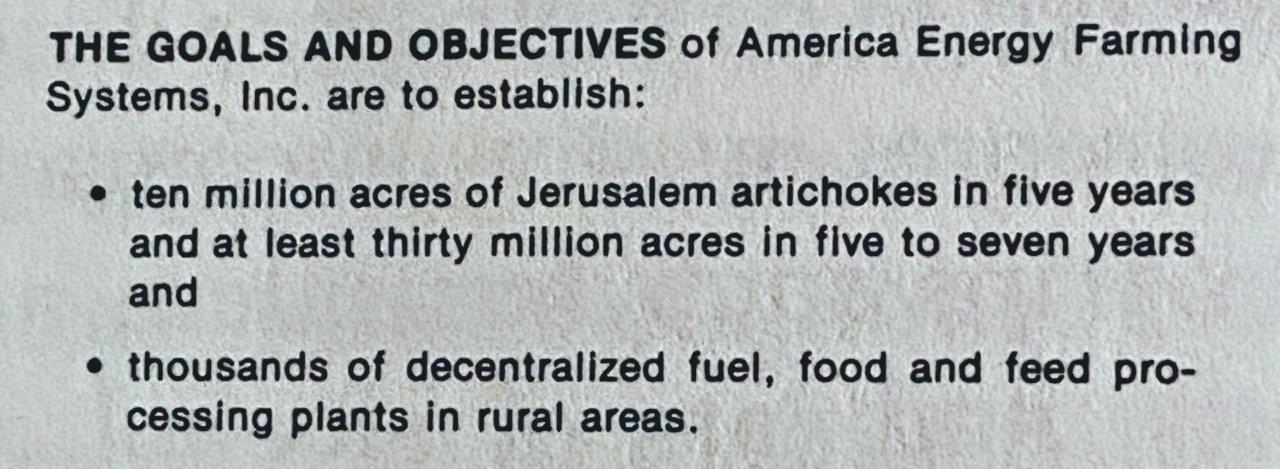
Ponzi-type schemes have always poked at the soft belly of agriculture, but as Amato makes clear, the artichoke affair was made far worse by a confluence of circumstances. “They played with the hopes of so many farmers who had nothing left to mortgage, and took advantage of people already on the road to ruin, and to make it that much worse, threw in religion as their sweetener. They were selling hope, and as it turns out, nothing else.”
Name It and Claim It
In a sense, Hendrickson first had to con himself, Amato believes. “Hendrickson was a big believer in televangelists and prosperity, but sincerity only ran so far and then he was broke. When the dough started to roll in from Jerusalem artichokes, the cash register started chiming and all those years of not making it and having his schemes fail pushed him do anything.”
Iron sharpens iron, for the good and the bad. During the abandoned Igloo Project, Hendrickson encountered James Dwire as a potential source of construction work. Dwire owned a road contracting company located in Lynd, Minn., farmed on the side, and was a fellow advocate of alternative energy. “Dwire’s business was hurting,” Amato says, “and he needed big cash to save his business and land. No doubt he suddenly picked up religion, but he used it as a means to get enthusiasm from others.”
Hendrickson shared his vision with the like-minded Dwire, who proceeded to plant a trial plot of Jerusalem artichokes. Several years later, at Hendrickson’s trial, Dwire recalled the crop: “By fall the foliage was so thick you could hardly walk through the field and the crop literally sold itself to the farmers...We literally stood out in the field one day, and I looked at Fred, and I said, ‘You know what we ought to do, we ought to market this crop,’ cause there was nobody marketing it, and I seen it was an opportunity too—I was a real believer in the artichoke, and I seen it was an opportunity to get into business and help a lot of other farmers.”
The new business duo began putting the artichoke pieces together, ostensibly to build up farmer-customers, set up decentralized processing plants, and solve energy issues in perpetuity. Out of the gate, Hendrickson was the idea man and Dwire was the financial muscle, with the pair cofounding the ill-fated American Energy Farming Systems (AEFS) in 1981, headquartered in Marshall, the seat of Lyon County, in southwestern Minnesota.
In need of dynamic promotion coated with a satin finish of divinely-derived prosperity, Hendrickson brought in Rev. L.D. Kramer as a promotional front-man. Kramer, a former television preacher with a questionable business background, including a failed nursing home chain and SEC trouble, dressed the part: fancy suits, shiny shoes, diamond ring and a name-it-and-claim-it theology. Officially a consultant, Kramer’s added presence to Hendrickson and Dwire ensured AEFS’ three-ring circus was presided over by a Big Three.

“Kramer was literally a televangelist and one of the first to go from radio to television,” Amato says. “They brought him in to act as a fulltime booster.”
As the grand builder of the Jerusalem artichoke house of cards, Hendrickson set up test plots, acquired seed, wrote sales literature, hired a multitude of personnel, and conducted sales seminars. Essentially, he set up a build-it-and-they-will-come model based on very little beyond belief, but for desperate farmers clawing for a toehold in a time of crisis, belief in Jerusalem artichokes was backed by a stunning sales pitch from AEFS: Up to $30,000-$40,000 per acre profit while the market burned hottest during the early days. With corn notched at roughly $100 per acre in comparison, the contrast was a jaw-dropper.
Down Goes the Ayatollah
Hendrickson trumpeted Jerusalem artichoke as the “weed that whips OPEC” and a plant to save the family farm. Growers were offered a three-year AEFS contract: $12,000 to cover seed for 10 acres (1,000 lb. seed per acre; $1.20 per pound) and the acquisition of AEFS as marketing agent. Additionally, AEFS would develop harvest machinery and offer custom planting.
AEFS projections pointed to 500 contracted farmers growing ample seed for 450,000 other farmers by 1984. The exponential math was a harbinger of trouble, and rested on assurances that Jerusalem artichokes would herald a new day for alcohol fuel, put an end to the farm crisis and energy crisis, as well as become a catch-all crop for the production of sucrose, insulin, livestock feed and human-grade food. The future of humanity, according to AEFS, was on every farmer’s doorstep.
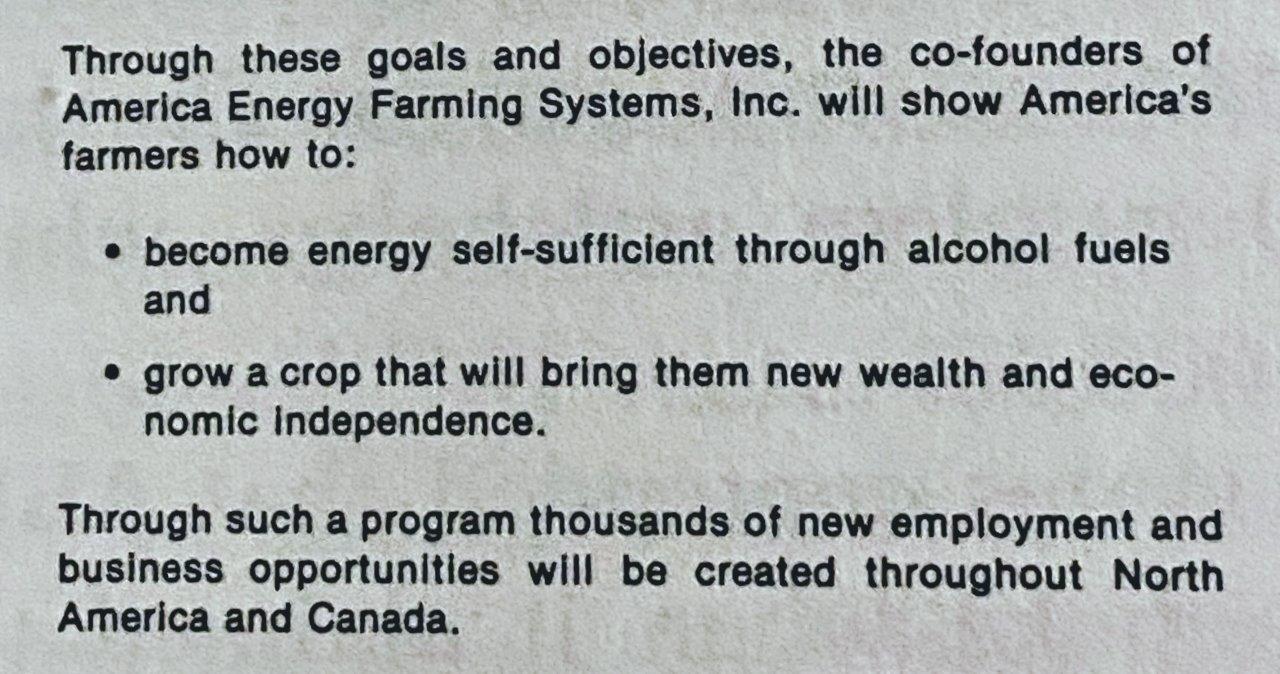
And how did farmers respond? They came in droves. Initially, AEFS planned for a kickoff of approximately 200 producers across a six-state footprint. Instead, 450 farmers answered the bell, clamoring for the miracle crop—cash in hand. The mania was on and an expanding line of hopeful farmers stretched out the door; all for a crop with no market.
Many of the farmers were already on a financial last leg, hoping to catch a flyer, Amato explains. “So many of them were already marginal and needed a dream to come true. They borrowed $10,000-$12,000 for 10 acres of seed and were promised 30 or 40 times the amount in return. There were even machinery dealers, who weren’t selling tractors, who bought in as speculators. The weaker the land, or the more indebted, those were the farmers most often involved in Jerusalem artichokes.”
By December 1981, AEFS had plucked $2 million from farmer pockets. January 1982, was even better—$6 million. The artichokes were a cash machine, and in a flash, AEFS had nine regional representatives and up to 40 state representatives. Sell, sell, and sell. Sell some more. A surreal Ponzi bash had officially begun, and although the stroke of midnight was coming, the party was about to descend to complete folly and absurdity. According to AEFS, Jerusalem artichokes were the antidote to global banking, OPEC, the Trilateral Commission, the Rothschilds, the evils of Big Ag, and Ayatollah Khomeini. Welcome to bizarro world.
Anoint Me With Artichokes
Basking in the million-dollar confirmation of Jerusalem artichokes as a divinely guided plant, AEFS’ Big Three organized an inaugural company-wide convention in 1982, harnessing old-time religion. Three days in duration, and with 1,000 attendees, the business meeting was also a revival, aimed at rallying the army of believers toward financial abundance, biblical eschatology, and an energy-saving hammer blow to the gonads of OPEC.
Speakers by the dozen took the stage, covering all things artichoke-related, agronomics, best management, byproducts, purported markets, and a heaping of spiritual fervor. Significantly, two of the keynote speakers claimed to have been raised from the dead, Amato recalls. “One of the two even said she’d spent a day in heaven. The whole meeting was intended to present Jerusalem artichokes as a salvation crop for farmers and the energy crisis. These guys were using religion to bring in more customers and inspire those who were already customers.”
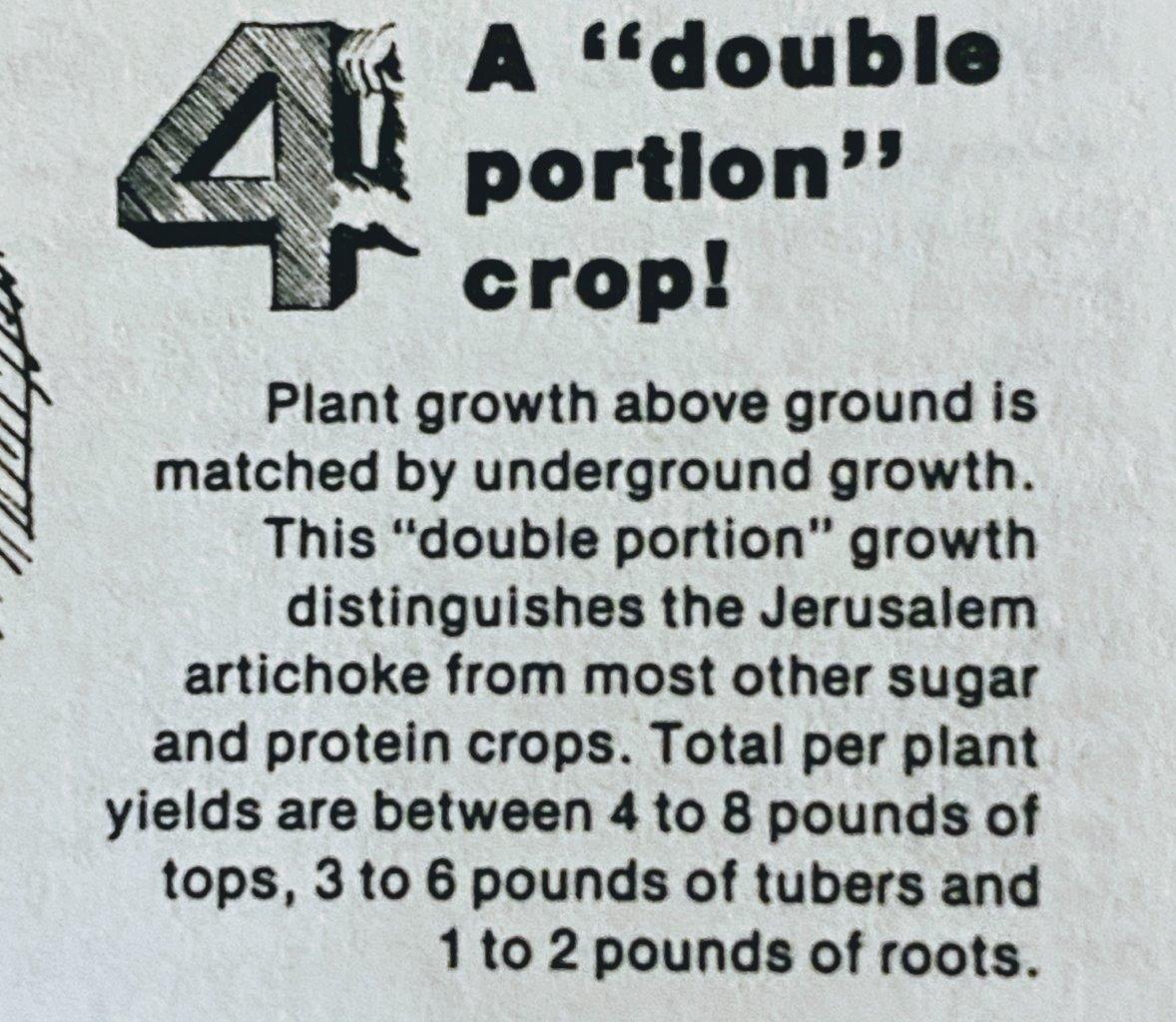
Don Sheenan, according to Amato’s research, a key member of AEFS’ sales staff summed up the fervor with a quote for the ages: “Anoint me with artichokes and set me on fire.”
“It was all a mix of religion and business,” adds Peter Kasal. “The first half of the meeting was about business; the second was about how God was behind the artichokes.” Kasal, McLeod County prosecutor, would later pursuit criminal charges against Hendrickson, Dwire—and Kramer. “It was a real Elmer Gantry-type deal, and Kramer was right in the middle, a big force in stirring the pot,” Kasal adds. “He looked just like a like a typical, diamond-wearing televangelist.”
Kramer had an affinity for acronyms, and when it came time for his meeting presentation, he capsulized the movement with MONEY. M, God is for me; O, opportunity; N, necessity of surrendering to God; E, Energy within you greater than OPEC; Y, you must apply faith.
In addition to Kramer’s antics, the very earliest farmer-customers into the game were highlighted during the meeting, including South Dakota grower Andy Van Zee, presented with a $500,000 check. Van Zee was proof positive of the blessings around the corner for prospective growers, but in reality, a Ponzi scheme, by design, is always golden for the initial players.
If not Elmer Gantry-esque, the three-day show was at least P.T. Barnum-inspired, and it added fuel to an already raging fire, and opened the door wider for sales and more sales. Meanwhile, the band, or at least the church organ literally installed by Hendrickson in the AEFS headquarters building, played on.
Sticky Fingers
In 1982, Hendrickson produced an AEFS state of the union report, boldly calling for a “Marshall Plan of American Agriculture.” He presented a phenomenal projection, estimating a decade of continued growth would see 100 million acres of Jerusalem artichokes. Broken down, the acreage would include 10 million for fructose; 10 million for flour; 20 million for livestock feed; 30 million for alcohol fuel; and 30 million for human consumption
Each acre planted was theoretically capable of at least a 20,000 lb. yield, and if acreage hit 100 million, total yield per year would reach 2 trillion lb. The calculation was elementary, according to AEFS: energy independence was within reach of the American farmer.
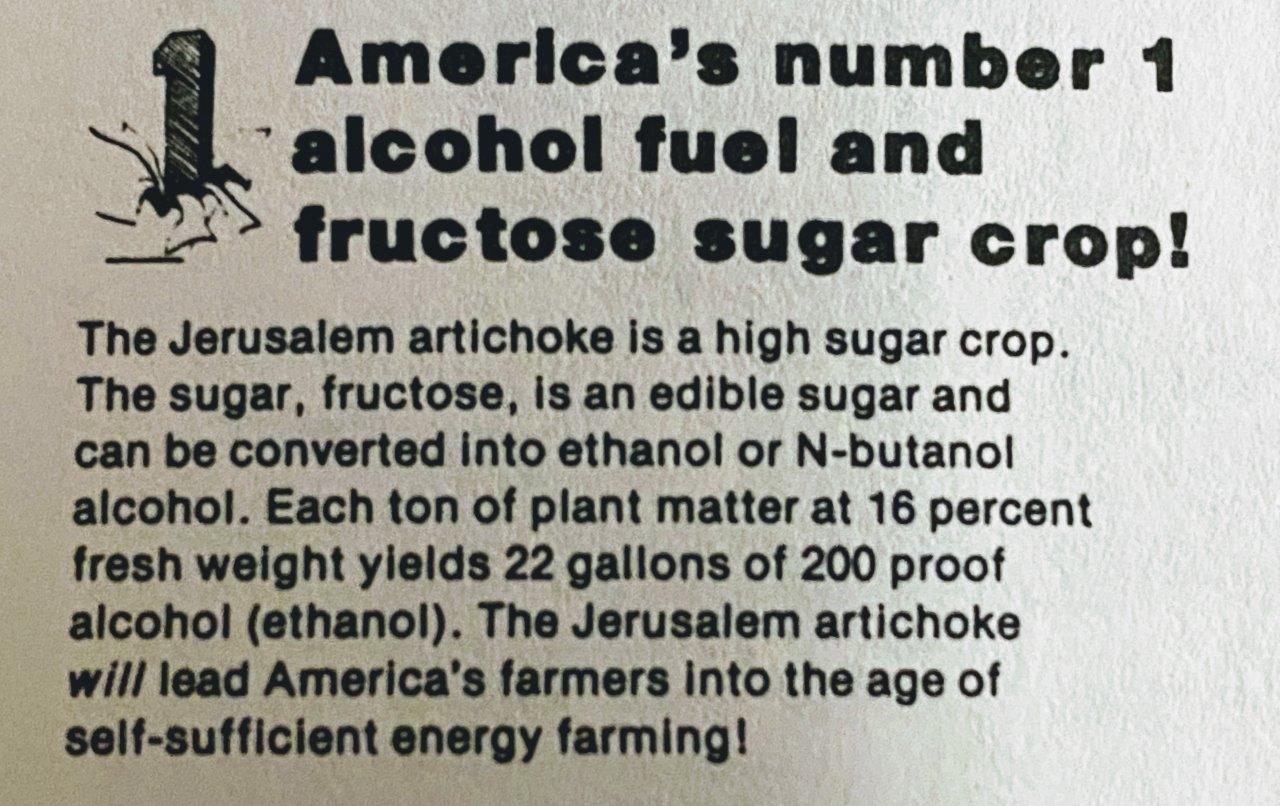
By 1982, where were the bulk of AEFS farmers? 509 in Minnesota; 288 in South Dakota; 255 in Iowa; 246 in Wisconsin; 92 in Kentucky; 90 in Missouri; 81 in North Dakota; 75 in Indiana; 70 in Illinois; 58 in Nebraska; and scattered numbers in many other states.
AEFS heavily promoted Jerusalem artichoke family identity for farmer customers with tall plant contests, recipe books, promotional paraphernalia, a traveling artichoke bus, multiple publications and heavy advertisement. Despite AEFS’ success in bringing increasing numbers of farmers into the family fold, alarm bells were ringing in various agriculture quarters as far back as October 1981. University of Minnesota Extension issued a prescient memo alerting regional agents: “A firm in Lyon County promoting the growing of Jerusalem artichokes as a crop overestimates the yields of the plant as well as the plant’s potential for conversion to alcohol fuel and sugar, and even human food.”
Two months later, in December 1981, Mark Seetin, Minnesota’s commissioner of agriculture, asked the attorney general’s office to investigate AEFS’ curious dealings. Also in December, the media caught wind as the Sioux Falls Argus Leader began asking questions and ran an appropriate headline: “Jerusalem Artichoke Production Questions.”
Yet, AEFS charged forward, hauling in farmers hand over fist, even with no commercial artichoke markets for fuel, animal feed or fructose, and no fuel processing plants on tap. Although creaking, the pyramid was rising ever higher, and all the while, the Big Three pulled from the AEFS purse with sticky fingers.
The Pipedream Cometh
Outside of Lake Benton, Minn., a mile from the South Dakota border, Jim Nichols farms along the Buffalo Ridge, where the glacial advance ended and deposited rocky clay across hilly ground. At 2,000’ in elevation, Nichols’ Lincoln County property is battered by cold winds and sits atop one of the highest points in Minnesota.

A political independent, Nichols ran for state senate in 1976, juggling politics and agriculture for five years, before stepping away from St. Paul in 1981. Nichols was appointed state agriculture commissioner in 1983, and during his tenure, he had a direct hand in benchmark agricultural change, authoring the Conservation Reserve Program (CRP) bill and steering Minnesota’s 1991 ethanol mandate.
“The early 1980s farm crisis was so brutal that people today don’t realize how bad it truly was,” Nichols recalls. “We had 103,000 farmers in Minnesota and 33,000 faced foreclosure by the mid-80s. The whole atmosphere was ripe for con-men.”
Significantly, Nichols lived a mere 40-minute drive from Marshall and AEFS. Watching as several of his neighbors planted Jerusalem artichokes, Nichols smelled rot from the start. “It was an absolute scam from top to bottom. The first farmers in sold their crop for seed and made profit, and that made everything worse. It was obvious that in just a couple years, the fake market would be flooded with seed.”
“Jim Dwire was such a big promoter and he led one public meeting after another, at community centers or high school gyms or VFWs, and he’d talk about all the money guys were making selling seed, Nichols continues. “But he never, never talked concrete about the market, because he was the market.”
As AEFS presence spread, Nichols called Dwire’s office and insisted on an end to the artichoke charade. Dwire, attempting to place AEFS in a positive light and recognizing Nichols as a serious impediment, began trying to curry promotional favor. Dwire couldn’t go the Minneapolis Grain Exchange and he couldn’t go to the corn or soybean associations. Instead, he sought multiple meetings with Nichols.
“I never saw him without his Bible,” Nichols describes. “I don’t know if he was religious, but the Bible had never been part of his business or appearance before Jerusalem artichokes. He needed to project an image of truth and integrity, and that Bible stayed under his arm.”
The exchange between Nichols and Dwire grew increasingly heated as Nichols didn’t cotton to a word of Dwire’s spiel. In short time, Nichols began publicly calling Dwire a con-artist, and issued press releases with a clarion message: Jerusalem artichokes have no market. Dwire responded with a lawsuit—and Nichols didn’t blink. “There’s no other way to say it,” Nichols emphasizes, “it was a total scam by con-men—a faith-based pipedream.”
Finding the Pony
Scarce only a year prior, artichoke seed began flooding AEFS by late spring 1983. Strapped with at least 10 million lb. of warehoused artichokes, AEFS choked on its own lifeblood. With $19 million in unpaid debt and $2.5 million in cash, AEFS filed Chapter 7 bankruptcy on May 23, 1983.
Despite the financial collapse and clear indications of a cauldron filled with violations, DOJ, FBI, USPS, and other agencies kept their prosecutorial feet on the sidelines. At first blush, it seemed the Big Three would skate, subject to civil lawsuits, but not criminal prosecution. Enter Peter Kasal.
Raised on a farm close to Glencoe, Minn., Kasal had seen plenty of hustlers as McLeod County prosecutor, and he brooked no tolerance for white collar criminals. While every other governmental body engaged in various degrees of navel gazing, Kasal waded into the fray. “No other law enforcement agency was willing to enter in. Nobody seemed interested,” Kasal says. “Nobody would put a foot forward. It really bothered me because this was no penny-ante deal. This was not a tiny handful of people getting screwed. This was a large outfit affecting a great deal of people. I knew there were larger agencies better equipped to handle such a large scale operation, but when I made calls, I was flatly told, ‘No. I’ve got better things to do.’”

Kasal held a particular distaste for criminals who wielded piety as a lever. Several years prior to AEFS, Kasal successfully prosecuted an insurance agent in western Minnesota who used prayer to profit. “He would meet with couples to sell them life insurance, and beforehand ask to sit with them and have 10 minutes of quiet prayer to consider the policy. He used religious posturing to make them think he was legit, and then he’d pocket their money and walk away. I’ve always found religious cheats to be particularly disgusting.”
Kasal’s attention to detail was initially disregarded by AEFS officials—much to their own peril. Translation: The Big Three severely underestimated Kasal. “A local county attorney was looking into their affairs,” he says. “They didn’t think that was too significant.”
However, Kasal was a bulldog prosecutor with a farming background, tenacious to the core, and he immediately recognized the nuances involved in the AEFS abuse. “The basic premise they presented was, ‘Until we have a stable supply of product, we can’t form the market.’ It’s ass-backwards, but they claimed volume was required to have a market.”
“They took advantage of people who were grasping at straws and promised them tens of thousands of dollars per acre,” Kasal continues. “Farmers believed just one year of profit might save their farms. So many of these farmers were already at a breaking point, and suddenly they found a chance at a Hail Mary pass. I have no sympathy for criminals that take people out of the pot and into the fryer.”
Kasal used a grand jury to gain access to AEFS documents and began connecting the dots via a mountain of records. The challenge of untangling the massive paperwork knot to trace the flow of money between banks, shell accounts, and genuine accounts is best summed by a Kasal quote in Amato’s book, The Great Jerusalem Artichoke Circus: “A white collar crime is a million documents, which is a room full of pony s***, and the trick is to find the pony therein.”
With Kasal’s lead investigator, Jim Newes, a former postal inspector with a mathematician’s eye for numbers, on the AEFS case, the money trail came into full view and revealed diversion of corporate profit and swindle. “One of their biggest promotions was assuring farmers that half the money sent to AEFS was set aside in a safety fund, and guaranteed in case things went off the rails,” Kasal notes. “That was totally false like most everything else. They took out money as fast as it came in.”
In 1987, Dwire avoided a trial and pled guilty to theft by swindle: six months in prison, five years of work release and a $5,000 fine. Hendrickson and Kramer refused to budge, brazenly attributing their actions to altruism during separate trials in Mankato. Time and again, Kasal showed them one damning document after another: “You were helping people by stuffing your pockets?”
Hendrickson and Kramer were found guilty of theft by swindle and conspiracy to commit theft by swindle. Six months in jail for Hendrickson, while Kramer received a one-year sentence and $5,000 fine. In arguably the most bizarre moment of the entire Jerusalem artichoke affair, Kramer confronted Kasal and Lewis in the courthouse hall during a break in proceedings, revealing a theological twist and apparent lack of remorse: “I know God has forgiven me. Why haven’t you forgiven me? Are you greater than God?”
Foxes in the Henhouse
At the helm of bringing down three of the most infamous Ponzi schemers in U.S. history, Kasal rarely thinks back on the case, but can’t forget the plight of farmers caught in the AEFS web. “Once I started, I felt sorry for the people taken advantage of that needed help during a time of real need. Not only did these men not help them, but they cheated them. The moral aspect troubled me and stays with me.”
In the end, Hendrickson, Dwire and Kramer sold $25 million in Jerusalem artichoke seed to at least 2,500 farmers in over 30 states and three Canadian provinces. The numbers are sobering, but could have been far bigger, according to Kasal: “Just one more year of selling, by itself, and they would have sucked in much, much more money.”
Amato concurs with Kasal’s assessment, and says Hendrickson and Dwire were planning on buying a bank. “They were hoping to buy a bank in Ruthton (Pipestone County) and turn the investments into stocks to solicit money. In other words, they had operational minds to make the cash go further. They were experts in looting their own company, like foxes in their own henhouse.”
And of the Big Three, were they complete con-men, true believers, or in-between hybrids?
“Dwire was a combination,” Kasal says. “He started with belief and got swept away by the flow of money. Kramer was a con-man through and through. Hendrickson...I’m just not sure. But when the three men got together, the sparks began to fly.”

What became of the mountains of Jerusalem artichoke tubers? “Hell, they rotted in the fields,” Nichols says, “or they were harvested and rotted in giant piles.”
“Hard to believe, but it’s all true and really happened,” Nichols adds. “It was the craziest thing I ever saw in my career. Most of the farmers still around that were involved won’t touch the topic. Farmers don’t like to talk about a crop they grew, but were never able to sell.”
For more, see:
US Farming Loses the King of Combines
Ghost in the House: A Forgotten American Farming Tragedy
Rat Hunting with the Dogs of War, Farming's Greatest Show on Legs
Misfit Tractors a Money Saver for Arkansas Farmer
Predator Tractor Unleashed on Farmland by Ag's True Maverick
Government Cameras Hidden on Private Property? Welcome to Open Fields
Farmland Detective Finds Youngest Civil War Soldier’s Grave?
Descent Into Hell: Farmer Escapes Corn Tomb Death
Evil Grain: The Wild Tale of History’s Biggest Crop Insurance Scam
Grizzly Hell: USDA Worker Survives Epic Bear Attack
A Skeptical Farmer's Monster Message on Profitability
Farmer Refuses to Roll, Rips Lid Off IRS Behavior
Killing Hogzilla: Hunting a Monster Wild Pig
Shattered Taboo: Death of a Farm and Resurrection of a Farmer
Frozen Dinosaur: Farmer Finds Huge Alligator Snapping Turtle Under Ice
Breaking Bad: Chasing the Wildest Con Artist in Farming History
In the Blood: Hunting Deer Antlers with a Legendary Shed Whisperer
Corn Maverick: Cracking the Mystery of 60-Inch Rows







